Projects and services supported by Nepal School Projects
|
NSP in Numbers
|
|
NSP Successes
Sanitation
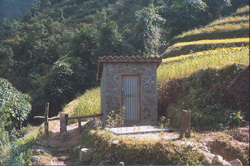
In 1995, NSP introduced sanitation as an integral part of our drinking water program in 1995. Initially, we were unable to sell the villagers on the idea of having a simple pit latrines close to their homes. UNICEF promoted such latrines and even published a manual on how to construct one. However, the concluding paragraph stating that the pit latrine should be replaced every four years made the villagers reject sanitation. We have consulted other NGOs on their experience with sanitation to find alternatives to pit latrines. Since we have made sanitation mandatory part of all school projects, we have decided to offer a simplified version to the villagers. The latrines are of identical size, have the same high quality fixtures except for the running water tap inside. The latrines are being constructed by the benefiting villagers under our technical supervision. Since the latrines are permanent, the sanitation program became an unqualified success. The two illustrations above are samples of recently constructed latrines. The one on the left even has a running water tap inside. Since we have been mandated by CIDA to provide assistance with sanitation to all households that received our assistance with drinking water systems, we have received more than 3,000 requests for assistance with their construction. Following the establishment of biogas industry in Nepal, we have made the necessary design modifications so that they can be retrofitted with biogas plants and biogas cooking stoves.
Safe Drinking Water Projects
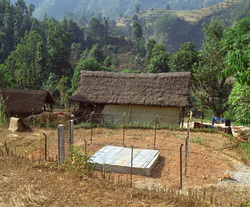
At the time we initiated development activities within the southern Mahabharat, our initial objective was to provide assistance with primary school construction. However, already during the first year of our presence within the region, the applications for assistance with drinking water systems far outnumbered those for school construction. While schools can be constructed only in those communities that have been authorized as education centres by the district government in order to qualify for government appointed and paid teachers, every village needs water. Thus, gravity-fed drinking water systems to the Mahabharat hill villages currently represent our main development activity. The lack of water within the community also puts an extra burden on the village women who, by local tradition, are the main water carriers. Furthermore, water taken out of a ground well, where available, is usually polluted.
Although the customary water system parameters in Nepal allocate one tapstand to be shared by five households, we have been quite liberal in tapstand allocation. Since the average rural household has about ten inhabitants, we have found that the one to five ratio does not adequately meet the needs of the local people. We are currently providing an average of one tapstand for every two households. Our tapstand design is also quite cost effective and the provision of additional tapstands makes little difference in the overall project expenditure. However, even with our liberal household to tapstand ratio, an average of ten to twenty people must share one water tap.
In addition to the labor saving benefits by not having to carry water from distant sources, there are also health related benefits derived from the availability of safe water within the village. Nepal is among the countries where less than twenty percent of rural population has an easy access to safe drinking water. About 80% of world's disease is related to a lack of clean drinking water. In Asia, about 20 million people become infected by guinea worm disease every year, as a result of drinking polluted water. The health of the people is a basic need, whose satisfaction must be the foremost goal of any development activity. Furthermore, it is a prerequisite for economic and social development, only healthy people can fully utilize their capabilities.
Although the customary water system parameters in Nepal allocate one tapstand to be shared by five households, we have been quite liberal in tapstand allocation. Since the average rural household has about ten inhabitants, we have found that the one to five ratio does not adequately meet the needs of the local people. We are currently providing an average of one tapstand for every two households. Our tapstand design is also quite cost effective and the provision of additional tapstands makes little difference in the overall project expenditure. However, even with our liberal household to tapstand ratio, an average of ten to twenty people must share one water tap.
In addition to the labor saving benefits by not having to carry water from distant sources, there are also health related benefits derived from the availability of safe water within the village. Nepal is among the countries where less than twenty percent of rural population has an easy access to safe drinking water. About 80% of world's disease is related to a lack of clean drinking water. In Asia, about 20 million people become infected by guinea worm disease every year, as a result of drinking polluted water. The health of the people is a basic need, whose satisfaction must be the foremost goal of any development activity. Furthermore, it is a prerequisite for economic and social development, only healthy people can fully utilize their capabilities.
Primary School Construction
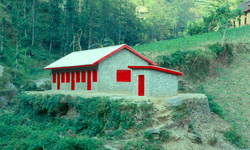
As recently as the 1950s, Nepal had virtually no schools. With the exception of the higher caste people, the majority of the population was illiterate. Although the literacy, especially in urban centres, has greatly improved over the years, in the remote regions of the country the majority of teen and adult population still can neither read or write. This is mainly due to the absence of schools in remote rural regions of the country.
Virtually all rural schools constructed through total self-help are usually very poorly designed, often windowless, and the classrooms are too small. The Charkilla primary school illustrated above is a typical such example. In our project area, many total self-help schools were usually nothing more than an open shelter with a thatched roof. Due to the economic realities in Nepal, the local government's sources of revenue are quite limited. As a result very few major public works projects can be undertaken without external assistance. Although education for all ranks very high among the country's priorities, the government just does not have the financial resources to provide all the basic needs in education.
For instance, in Nepal the government does not construct primary schools. Any community desiring education for their children must construct and maintain suitable premises with their own resources. In return, the government will provide teachers and pay their salaries. This system, although it is not as strictly enforced today, has resulted in an uneven distribution of educational facilities with the very poor communities being the disadvantaged.
It was in this area where our organization has played an important role by providing technical expertise and material aid with primary school construction to the poorest villages in the hill regions of Kabhre Palanchok district, thus enabling very poor children to have an access to basic education up to grade five. All NSP assisted school projects, like the Thulo Pokhara school illustrated above, are being constructed by graduates from our own vocational training program.
The education of a child must also be seen in a broader perspective that is interlinked with social and economic upliftment of the rural community. Furthermore, about one half of the children that benefit from NSP supported school projects are non-Nepali speaking Tamangs, and through school attendance they are being introduced to the basics of the national language.
Virtually all rural schools constructed through total self-help are usually very poorly designed, often windowless, and the classrooms are too small. The Charkilla primary school illustrated above is a typical such example. In our project area, many total self-help schools were usually nothing more than an open shelter with a thatched roof. Due to the economic realities in Nepal, the local government's sources of revenue are quite limited. As a result very few major public works projects can be undertaken without external assistance. Although education for all ranks very high among the country's priorities, the government just does not have the financial resources to provide all the basic needs in education.
For instance, in Nepal the government does not construct primary schools. Any community desiring education for their children must construct and maintain suitable premises with their own resources. In return, the government will provide teachers and pay their salaries. This system, although it is not as strictly enforced today, has resulted in an uneven distribution of educational facilities with the very poor communities being the disadvantaged.
It was in this area where our organization has played an important role by providing technical expertise and material aid with primary school construction to the poorest villages in the hill regions of Kabhre Palanchok district, thus enabling very poor children to have an access to basic education up to grade five. All NSP assisted school projects, like the Thulo Pokhara school illustrated above, are being constructed by graduates from our own vocational training program.
The education of a child must also be seen in a broader perspective that is interlinked with social and economic upliftment of the rural community. Furthermore, about one half of the children that benefit from NSP supported school projects are non-Nepali speaking Tamangs, and through school attendance they are being introduced to the basics of the national language.
Training for Gainful Employment
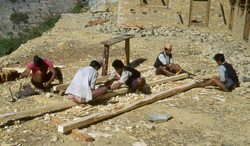
Nepal lacks any broad-scale vocational training facilities for young people. The shortage of skilled labor in our project area has been a major obstacle during the early years of NSP aid with school construction. Since all NSP projects offer skill training opportunity for young people, we have established our own hands-on vocational training program in a variety of skills for young adults. Although the majority of our apprentices during the early years of NSP were illiterate - there were no schools within their home regions when they were of school age - their lack of basic education has not been a barrier in the learning of a manual skill. The vocational training program has been indispensable to all our projects. It has not only produced many outstanding tradesmen but has also provided us with the right kind of skilled labor we needed in project implementation. All skilled tradesmen and foremen working on NSP supported projects received their training through NSP, and the high standard of workmanship reflected in all our projects is entirely due to their high level of achievement. The Thulo Pokhara school illustrated above is just one example.
Assistance with wire bridge construction
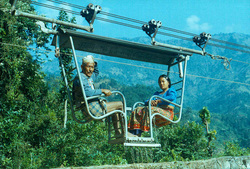
All rivers within the region and along the district boundary can be forded during the dry season, however, communication or transportation requiring the crossing of a river becomes impossible during rainy monsoon season. Suspension bridges are very costly and beyond the scope of NSP aid. A local entrepreneur designed a low cost alternative to a suspension bridge - a wire suspended carriage moved across a river by pulling a cable can transport two adult persons or a load equivalent to 300 kilograms at a tiny fraction of suspension bridge cost. With the villagers donating all the local materials, such as stone and sand as well as transport of all bridge components to the site, these bridges are very cost effective. During 2000 - 2004, we have assisted with the construction of eight wire bridges.
Primary Health Care
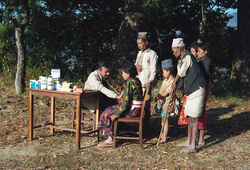
The high incidence of sickness and above average mortality rate among southern Mahabharat's population, when compared to other parts of the district with easier access to medical care, is due to the primitive way of life and a virtual absence of health care facilities within the region. NSP is supporting the government's objective to gradually establish one health post in every VDC of country by providing assistance with the construction of health post facilities. As is the case with schools, the government does not have the resources to construct the village health posts, it will only appoint the health workers and pay their salaries. Although the village health posts usually lack adequate variety and quantity of medical supplies, the health workers can at least provide important diagnostic services to the local people to prevent a premature death.
In the past, with the help of a prominent Nepalese physician, we have trained a number of Mahabharat villagers as primary health care workers and have been providing them with donations of emergency medical supplies. At present, there are only five fully functioning health posts within the eleven VDCs of the region. Thus, these "barefoot doctors" provide an essential service to the people within their home area using the Nepalese translation of the village health care handbook "Where There Is No Doctor" by David Werner as their guide.
In the past, with the help of a prominent Nepalese physician, we have trained a number of Mahabharat villagers as primary health care workers and have been providing them with donations of emergency medical supplies. At present, there are only five fully functioning health posts within the eleven VDCs of the region. Thus, these "barefoot doctors" provide an essential service to the people within their home area using the Nepalese translation of the village health care handbook "Where There Is No Doctor" by David Werner as their guide.
Emergency Disaster Aid
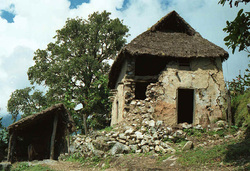
In addition to development aid, we have also provided emergency humanitarian assistance to the victims of natural disasters that had struck the region in recent past, such as the 1988 earthquake and the 1993 floods and landslides, when one hundred inches of rain fell within forty eight hours causing massive landslides in the hills and major floods in the valleys as well as a loss of life. When a natural calamity strikes, the local government is unable to provide a meaningful assistance to the victims, and the destitute families have no one to turn to for help but to their equally poor neighbors and relatives.